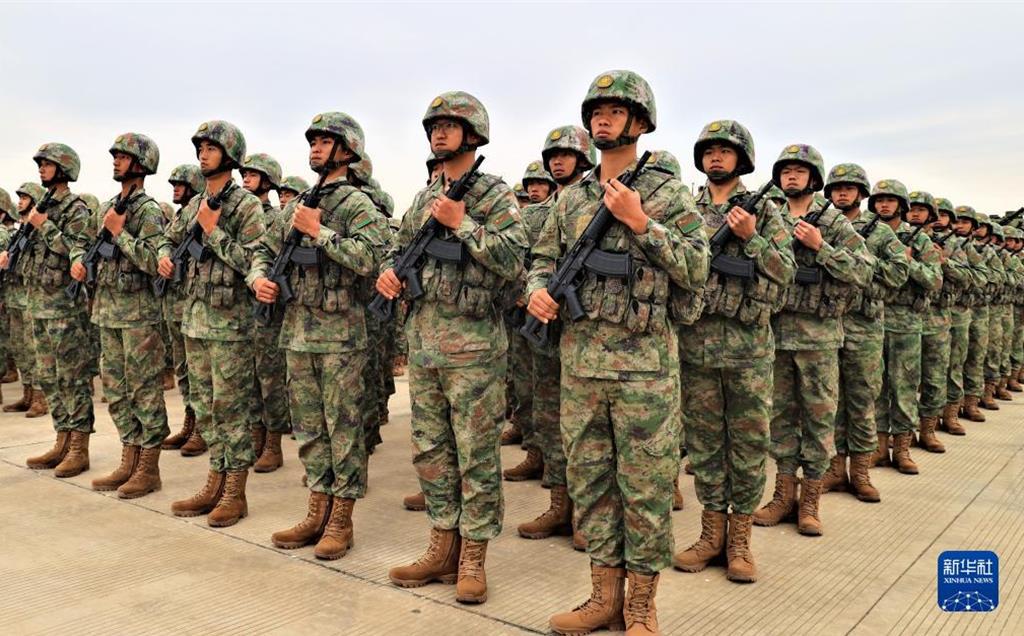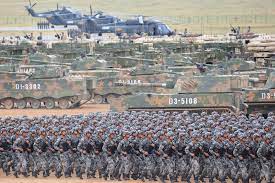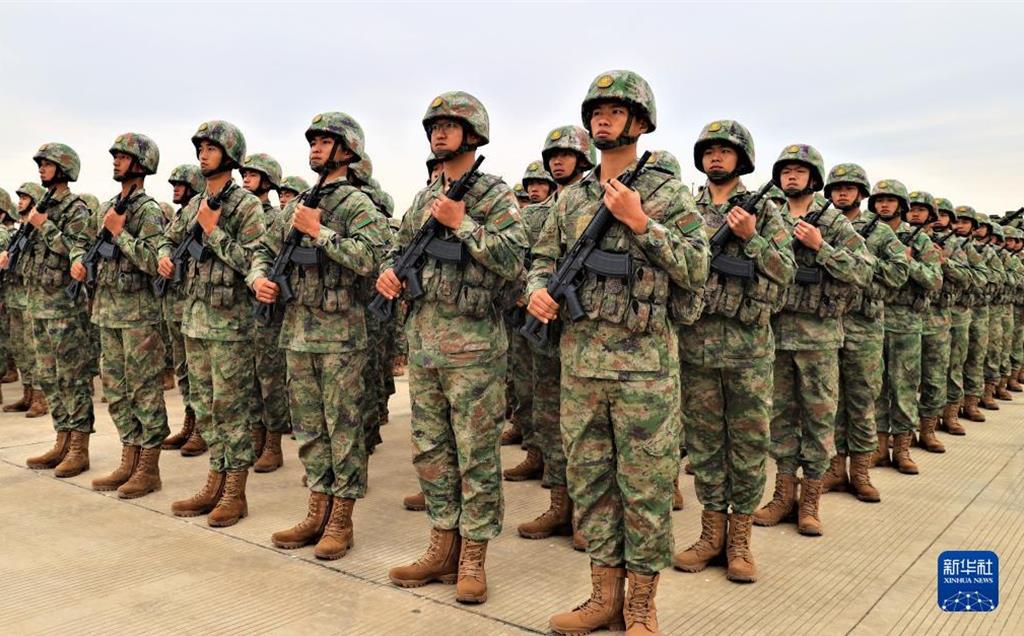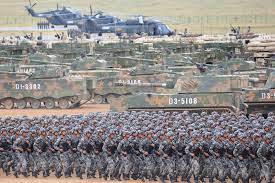中國軍隊重視系統優勢戰爭研究:資訊化戰爭如何打仗?九種典型戰鬥風格解析
現代英語:
System-based superior warfare is a system-based warfare in information warfare. It is not limited to a specific combat style, but a “combination punch” or a group of combat styles composed of multiple combat styles and tactics. It emphasizes that according to the changes in combat missions, combat opponents and battlefield situations, as long as it is conducive to forming relative advantages and achieving system victory, any appropriate combat means and styles can be flexibly used to form combat advantages. In the specific implementation of system-based superior warfare, these specific combat styles and action tactics can be organized and implemented separately as part of joint full-domain operations, and more emphasis is placed on “combination punches”, multiple strategies, and overall victory.
In order to better understand its core connotation, this article lists nine typical combat styles, including overall deterrence warfare, electromagnetic interference warfare, network attack warfare, cognitive control and interference warfare, and analyzes them.
System concentration warfare – a “combination punch” that flexibly uses a variety of combat styles. Author: Academic Plus Senior Observer Dong Zhou
The main content and keywords of this article
- Overall deterrence warfare: emphasize multi-domain joint deterrence; the implementation of overall deterrence warfare should have three major elements; strong overall strength is the core of achieving effective deterrence
- Electromagnetic interference warfare: the key to competing for information advantage; in terms of combined means and methods, information empowerment is achieved through “connection + sharing”; an effective method to crack unmanned cluster warfare
- Network attack warfare: mainly soft killing, combining soft and hard, focusing on breaking the network and reducing energy
- Cognitive control and interference warfare: control the cognitive right of situational awareness, compete for information advantage; control the right to command and decision-making, compete for decision-making advantage; control the “brain” right, and seize the brain control advantage
- Agile mobile warfare: high-efficiency and rapid decision-making; high-efficiency formation of a favorable combat situation; high-efficiency and instant aggregation of combat forces; agile mobile warfare is an innovative development of traditional mobile warfare
- Swarm autonomous warfare: conducive to forming a system advantage to suppress the enemy; conducive to enhancing combat effectiveness; conducive to trapping the enemy in combat difficulties
- Precision point killing war: achieve high efficiency and cost-effectiveness in operations; hitting key node targets is an important option; large-scale system support is a basic condition; it is inseparable from accurate intelligence support
- Supply chain disruption war: the supply guarantee chain has a huge impact on the overall operation; the focus of attack is the key node of the enemy’s supply guarantee chain; the key is to choose the right time to use tactics
- System destruction and paralysis war: the combat goal is to make the enemy’s combat system disordered; hit the key nodes of the combat system with a heavy punch; implement a soft attack on the enemy’s combat system
For learning reference only, welcome to communicate and correct! The views of the article do not represent the position of this organization
The concept of operation is first proposed as a new combat style. Innovative combat style is the core content of the development of combat concepts. It can be said that system-based optimization warfare is a general term for a series of specific tactics. The following nine typical combat styles constitute the combat method system of system-based optimization warfare. They are: First, overall deterrence warfare, actively organizing static power demonstrations and deterrence actions in the system-based superiority warfare, striving to win the battle without fighting or with a small battle; second, electromagnetic interference warfare, using a variety of combat means and action styles such as electronic reconnaissance, attack and defense to disrupt, prevent and destroy the enemy’s electromagnetic capabilities, actively compete for electromagnetic spectrum advantages, seize information control, and thus win the initiative in combat; third, network attack warfare, using a variety of means such as soft strikes and hard destruction to break the enemy’s command network, intelligence network, communication network, and logistics supply network, and disrupt the enemy’s command and support; fourth, cognitive control and interference warfare. Through information attacks, public opinion attacks, and brain attacks, control advantages are formed in cognitive space; fifth, agile mobile warfare. Rapidly adjust the deployment of troops and weapons, quickly gather capabilities on the battlefield, and seize combat opportunities; sixth, swarm autonomous warfare. Widely use unmanned combat means such as “swarms”, “wolf packs”, and “fish schools” to autonomously organize actions and distributed attacks to achieve human-machine joint victory; seventh, precision point killing warfare. Accurately obtain intelligence, implement multi-domain precision strikes, strive to hit one point to shake the overall situation, and maximize combat effectiveness; Eighth, supply chain disruption warfare. Organize elite forces to attack the enemy’s logistics and equipment supply chain, supply lines and supply bases, and destroy the enemy’s loss of supply and withdrawal from the battle; Ninth, system destruction and paralysis warfare. Comprehensively adopt a variety of means such as breaking the network, training, and hitting nodes to interfere with, delay, destroy or even paralyze the effective operation of the enemy’s combat system and weaken the function of the enemy’s combat system.
- Overall deterrence warfare
Overall deterrence warfare refers to actively organizing static power displays and deterrence actions in system-based superior warfare, striving to defeat the enemy without fighting or fighting a small battle. Sun Tzu said: “To defeat the enemy without fighting is the best of the best.” Deterrence and war are two main forms of military activities. Deterrence is mainly to show determination and will to potential opponents by showing strength or threatening to use strong strength to deter the opponent’s actions. It can be said that the overall deterrence warfare in the system-based superior warfare is an important means or tactics to achieve “stopping” the enemy’s troops without fighting. Clausewitz emphasized that the first rule of strategy is to be as strong as possible, first of all, strong in general, and then strong in key parts. Modern warfare is a confrontation between systems. The overall deterrence war under the informationized local war requires not only the traditional deterrence means and capabilities of land, sea, air and space, but also new deterrence means and capabilities such as space deterrence, electromagnetic deterrence, and network deterrence, and more importantly, the overall deterrence that demonstrates the overall strength of the country. In particular, with the rapid development of advanced technologies such as information technology, the scientific and technological revolution, industrial revolution, and military revolution are accelerating integration, and the coupling relationship between strategic competitiveness, social productivity, and military combat effectiveness is closer. Winning the informationized war is more of a contest of national will and national overall strength. If you want to contain the war, you must first deter your opponent from the overall strength.
1.1 Emphasize multi-domain joint deterrence
Deterrence means usually include nuclear deterrence and conventional deterrence. In the system-based superiority war, the overall deterrence war is implemented, aiming to comprehensively use the conventional deterrence means of the land, sea, air, space, and power grid in the whole domain to achieve the purpose of deterrence. In particular, with the application of information network technology and space and directed energy technology in the military, space, network, and electromagnetic weapons have become new means of deterrence. Space deterrence mainly uses rapid response electromagnetic orbital weapons, space-ground networked anti-navigation and positioning service systems, large elliptical orbit laser weapons, high-power microwave weapons and other equipment to threaten and attack the opponent’s space targets, forming an “interference and blocking” deterrence against the enemy’s space information. Network deterrence mainly uses cyberspace situational awareness and attack equipment to threaten and attack the opponent’s military network and other key information infrastructure to achieve deterrence against the enemy. Electromagnetic deterrence mainly uses electromagnetic spectrum combat systems to threaten and attack enemy detection, navigation, communication and other informationized weapon equipment systems to achieve deafening and blinding deterrence against the enemy. 1.2 Three elements should be possessed in the implementation of overall deterrence warfare
To implement overall deterrence warfare and achieve the expected deterrence effect, three elements are usually required: one is strength. The deterrent party must have reliable capabilities or strength that make the opponent feel daunted and fearful; the second is determination and will. The deterrent party must dare to use this capability when necessary; the third is clear information transmission. The deterrent party must accurately and effectively let the other party know its action capability and determination.
Historically, there are three main changes in the criteria for judging deterrence strength: first, active military strength; second, comprehensive national strength or war potential; third, the total number of main combat weapons and equipment. For a long period of history, the number of troops was deterrence, and the strength of military strength directly depended on the size of the active army, the number of important weapons and equipment, and non-material factors such as military training and organization morale. After the 20th century, with the expansion of the scale of war, deterrence strength is no longer limited to the number of troops and important weapons and equipment, but is determined by the country’s war potential, including economic strength, scientific and technological strength, energy resources, and even population size, etc. The overall deterrence war in the system-based superiority war, the formation of its deterrence strength is mainly based on the network information system, and the joint full-domain deterrence capability formed under the integration of the system.
1.3 Strong overall strength is the core of achieving effective deterrence
The development of information technology and its extensive penetration and application in the military field have provided favorable conditions for building overall strength and achieving overall deterrence. System-based superior warfare is supported by the network information system and makes full use of the penetration and connectivity of information technology. It not only integrates various combat forces, combat elements, and combat units into an organic whole to achieve military system combat advantages, but also connects and integrates various fields related to war and national mobilization, such as national politics, economy, diplomacy, finance, transportation, and energy, into the national war mobilization system, gathers various forces and resources to form an overall force, realizes the emergence effect of system capabilities, and shows the overall strength advantage. It forms a powerful invisible deterrent of unity and common hatred of the enemy, and creates a situation where the enemy “has power but cannot act” and “can act but has no effect”, which plays a role in containing and winning the war.
In the overall deterrence war, the scope of national war mobilization will be wider, not limited to a certain direction or region, but throughout the country and even relevant regions of the world; the mobilization time will be faster, and the mobilization and action information can be quickly transmitted to everyone and every node at the first time by using the network and information system; the action coordination and collaboration will be more consistent, and the forces distributed in various regions can act in a unified manner almost at the same time based on the same situation and the same order, greatly improving the efficiency of action coordination; the resource utilization will be more sufficient, and various war resources based on the network can quickly realize the transition from peace to war and from military to civilian, and realize the integrated and precise guarantee of the front and rear. - Electromagnetic interference warfare
Electromagnetic interference warfare refers to the flexible use of various combat means and action styles such as electronic reconnaissance, attack and defense to disrupt, prevent and destroy the enemy’s electromagnetic capabilities, actively compete for the advantage of the electromagnetic spectrum, seize the right to control information, and then win the initiative in combat.
2.1 The key to competing for information advantage Local information warfare is highly dependent on the electromagnetic spectrum, and the control and counter-control of electromagnetic space have become the focus of competing for the right to control information. Organizing and implementing electromagnetic interference warfare is mainly to destroy the enemy’s electromagnetic spectrum and protect one’s own side from destruction. The electromagnetic spectrum is the main carrier for transmitting information. Using electromagnetic means to disrupt and destroy the enemy’s electromagnetic spectrum will effectively reduce the enemy’s information combat capability, and enable the enemy to ensure the rapid and effective flow of information in the scenario where the enemy has the right to control information, and drive the command flow, action flow, material flow, and energy flow through the information flow, thereby gaining the dominance and initiative of the operation.
2.2 The basic focus is to disable and invalidate the enemy’s combat system. The implementation of electromagnetic interference warfare in the system-based superior warfare is mainly aimed at the enemy’s dependence on electromagnetic space. At the same time, in order to ensure the effective use of electromagnetic space by the enemy, various electronic reconnaissance, interference, attack, defense and support forces are organized to interfere with and attack the enemy’s communication network, radar network, computer network and command center, communication hub, radar station, computer network node, global navigation positioning system, space-ground integrated Internet and other space link systems, and other various frequency-using weapons and equipment, block and destroy their communication and data transmission, and destroy the “connection” and “sharing” structural center of gravity of the enemy’s combat system, and provide support for the seizure of information control and electromagnetic control from the root, thereby weakening the enemy’s command and control capabilities and disabling the enemy’s entire combat system.
2.3 Effective tactics to crack unmanned swarm warfare
Unmanned autonomous swarm warfare such as “bee swarm”, “wolf pack” and “fish pack” is an important feature of information-based local warfare with intelligent characteristics. There are a large number of various unmanned autonomous clusters, with various types and complex characteristics, and each individual can complement each other and replace each other to play a role. It will be very difficult to intercept and destroy the entire unmanned cluster. However, from a technical perspective, in order to achieve effective coordination in unmanned combat clusters, each individual must share and interact with each other. Once the communication coordination between unmanned clusters is interfered with, it will be impossible to share battlefield situation and information, and it will be difficult to coordinate actions with each other, and it will be difficult to play its due combat effectiveness. This provides an opportunity for the other party to implement communication interception and electromagnetic interference. Therefore, the implementation of electromagnetic spectrum warfare, interference and attack on the information and communication network of unmanned clusters, and destruction of their information sharing and interaction will make it impossible for each individual in the unmanned cluster to achieve effective coordination, thereby losing combat capability. - Network attack warfare
Network attack warfare refers to the comprehensive use of network and computer technologies and other effective means to conduct military confrontation actions around the control of information and information networks. It is a major combat style for cyberspace operations and the struggle for network control. Its main combat operations include both soft killing and hard destruction, mainly soft and hard. Among them, soft kill is mainly network attack, that is, the comprehensive use of blocking attack, virus attack and other means to block and attack the enemy’s information network, command system, weapon platform, etc., making it difficult for the enemy’s network, command information system, etc. to operate effectively or even paralyzed; hard destruction mainly uses precision firepower strikes, high-energy microwaves, electromagnetic pulses and anti-radiation attacks to paralyze the enemy’s information network physical facilities and destroy the enemy’s combat and weapon equipment entities.
The focus is on breaking the network and reducing the ability to fail. Organizing network attack in the system concentration war is to target the weaknesses of the opponent’s military information network, take advantage of the system, organize various network attack forces, and continuously implement soft kill and hard destruction actions against the enemy’s combat command network, reconnaissance intelligence network, communication network and even logistics supply network throughout the combat process, destroy the enemy’s network system, and make the enemy’s combat system function decline or even disabled as a whole. Mainly against the enemy’s basic information network, intelligence network, command network, support network and other core targets, implement a series of combat operations such as network and electricity coordinated attack, deception confusion, link blocking, takeover and control, so that the enemy’s intelligent combat network system is disabled and ineffective, and achieve a key victory in paralyzing the enemy system.
- Cognitive control and disturbance warfare
Cognitive control and disturbance warfare refers to the interference, destruction or control of enemy thinking and cognition through information attack, public opinion attack and brain attack in the system-based superiority warfare, so that the enemy cannot make correct judgments and decisions, thereby forming a control advantage over the enemy in the cognitive space.
The cognitive domain, that is, the human thinking space and consciousness space, is a field that has a key impact on combat decisions and judgments. The development of information technology, especially artificial intelligence technology, and its wide application in the military field have expanded the competition of war from physical space and information space to cognitive space, making cognitive space a new combat domain. With the development of information and intelligent technology and their extensive and in-depth application in the military field, human-machine intelligence tends to merge, making the status of cognition in intelligent warfare operations more prominent, and the cognitive field has gradually become an important battlefield. Controlling cognitive rights has become a key factor in future battlefield control rights. Fighting for cognitive control rights has become an important combat style for winning in informationized local wars with intelligent characteristics.
4.1 Controlling situational awareness and cognitive rights and fighting for information advantages
In the system-based superiority warfare, information flow drives material flow and energy flow, and information advantage determines decision advantage. The rapid and accurate recognition of intelligence information and battlefield situation has an important impact on gaining command and decision-making advantages. Therefore, in order to organize and implement system-based optimization, we must make full use of intelligent technology and big data technology to analyze massive intelligence information data.
國語中文:
體系聚優戰是資訊化戰爭中的體係作戰,其不限定特指某一種作戰樣式,而是由多種作戰樣式和戰法組成的“組合拳”,或作戰樣式群。強調根據作戰任務、作戰對手和戰場情勢變化,只要有利於形成相對優勢、達成體系製勝,可以靈活運用任何適宜的作戰手段和样式,形成作戰優勢。在體系聚優戰具體實施過程中,這些具體作戰樣式和行動戰法既可以作為聯合全局作戰的一部分單獨組織實施,更強調打“組合拳”,多策並舉,整體制勝。
為更能理解其核心內涵,本文列舉了整體威懾戰、電磁擾阻戰、網路破擊戰、認知控擾戰等九大典型作戰樣式,並進行分析。
體系聚優戰――靈活運用多種作戰樣式的「組合拳」作者:學術plus高級觀察員 東週
本文主要內容及關鍵字
1.整體威懾戰:強調多域聯合威懾;實施整體威懾戰應具備三大要素;強大整體實力是實現有效威懾的核心
2.電磁擾阻戰:爭奪資訊優勢的關鍵;在組合手段方法上,透過「連結+共享」實現資訊賦能;破解無人集群作戰的有效戰法
3.網路破擊戰:軟殺傷為主,軟硬結合,重在破網降能失效
4.認知控擾:控制態勢感知認知權,爭奪資訊優勢;控制指揮決策權,爭奪決策優勢;控制「腦」權,奪取腦控優勢
5.敏捷機動戰:高效率快速決策;高效率形成有利作戰態勢;高效率即時聚合作戰力量;敏捷機動戰是對傳統機動作戰的創新發展
6.蜂群自主戰:有利於形成體系優勢壓制敵方;有利於增強作戰效果;有利於陷敵於作戰困境
7.精確點殺戰:實現作戰的高效費比;打關鍵節點目標是重要選項;大範圍體系支撐是基本條件;離不開精確情報保障
8.補給斷鍊戰:供應保障鏈對作戰全局影響巨大;打擊重心是斷敵供應保障鏈的關鍵節點;重在選準時機活用戰法
9.體系毀癱戰:作戰目標是使敵作戰體系運作失序;重拳打擊作戰體系的關鍵節點;對敵作戰體系實施軟打擊
僅供學習參考,歡迎交流指正!文章觀點不代表本機構立場
作戰概念首先是作為一種新的作戰樣式提出。創新作戰樣式是作戰概念開發的核心內容。可以說,體系聚優戰是一系列具體戰法的總稱。以下九大典型作戰樣式構成了體系聚優戰的戰法體系。分別為:一是整體威懾戰,在體系聚優戰中積極組織靜態威力展示與威懾行動,力爭不戰或小戰而屈人之兵;二是電磁擾阻戰,運用電子偵攻防等多種作戰手段和行動樣式,擾亂、阻止、破壞敵電磁能力的發揮,積極爭奪電磁頻譜優勢,奪取制信息權,進而贏得作戰主動;三是網絡破擊戰,運用軟打擊和硬摧毀等多種手段,破敵指揮網、情報網、通訊網、後勤補給網,亂敵指揮保障;四是認知控擾。透過資訊攻擊、輿論攻擊、腦攻擊,在認知空間形成控制優勢;五是敏捷機動戰。快速調整兵力兵器部署,在即設戰場快速聚集能力,搶奪作戰先機;六是蜂群自主戰。廣泛運用「蜂群」、「狼群」、「魚群」等無人作戰手段,自主組織行動、分散式攻擊,實現人機聯合製勝;七是精確點殺戰。精準獲取情報,實施多域精確打擊,力爭打一點撼全局,實現作戰效益最大化;八是補給斷鏈戰。組織精銳力量,打敵後勤物資裝備供應補給鏈、補給線和補給基地,破敵失去補給而退出戰鬥;九是體系毀癱戰。綜合採取破網、鍛鍊、打節點等多種手段,幹擾、遲滯、破壞甚至癱瘓敵作戰體係有效運轉,削弱敵作戰系統功能。
1.整體威懾戰
整體威懾戰是指在體系聚優戰中積極組織靜態威力展示和威懾行動,力爭不戰或小戰而屈人之兵。孫子曰:「不戰而屈人之兵,善之善者也。」威懾和戰爭是軍事活動的兩種主要形式。而威懾,主要是透過展現力量或威脅使用強大實力,向潛在對手錶明決心意志,以嚇阻對手行動的行為。可以說,體系聚優戰中的整體威懾戰是實現不戰而「止」人之兵的重要手段或戰法。克勞塞維茨強調,策略的第一條規則是盡可能強大,首先是整體的強大,然後是在關鍵部位的強大。現代戰爭是體系與體系的對抗。資訊化局部戰爭下的整體威懾戰,不僅要有陸海空天傳統威懾手段和能力,也需要太空威懾、電磁威懾、網路威懾等新型威懾手段和能力,更需要有顯示國家整體實力的整體威懾。特別是隨著資訊科技等先進科技的快速發展,科技革命、產業革命、軍事革命加速融合,戰略競爭力、社會生產力和軍隊戰鬥力耦合關聯更加緊密,打贏資訊化戰爭更大程度上是國家意志和國家整體實力的較量。若要遏止戰爭,首先要從整體實力上對對手形成嚇阻。
1.1 強調多域聯合威懾
威懾手段通常包括核威懾和常規威懾。在體系聚優戰中,實施整體威懾戰,旨在綜合運用陸海空天電網全域常規威懾手段,以達成威懾目的。特別是隨著資訊網路技術及太空、定向能技術在軍事上的應用,太空、網路、電磁武器等成為新型威懾手段。太空威懾,主要以快速響應電磁軌道武器、天地網路化反導航定位服務系統、大橢圓軌道雷射武器、高功率微波武器等裝備,威脅攻擊對手空間目標,形成對敵空間資訊「幹擾阻斷」威懾。網路威懾,主要是以網路空間態勢感知和攻擊裝備,威脅攻擊對手軍事網路及其它關鍵資訊基礎設施,實現對敵威懾。電磁威懾,主要以電磁頻譜作戰系統,威脅攻擊敵探測、導航、通訊等資訊化武器裝備系統,實現對敵致聾致盲威懾。 1.2 實施整體嚇阻戰應具備三大要素
實施整體威懾戰並達成嚇阻預期效果,通常必須具備三大要素:一是實力。威嚇方必須具備令對手感到忌憚畏懼的可靠能力或力量;二是決心意志。威懾方在必要時必須敢於使用這種能力;三是明確傳遞訊息。威懾方必須將行動能力與決心準確、有效地讓對方清楚知道。
從歷史上看,判斷威懾實力的標準主要有三個面向變化:一是現役軍事力量;二是綜合國力或戰爭潛力;三是主戰武器裝備總數。在相當長一段歷史時期內,軍隊數量就是威懾,軍事實力的強弱直接取決於現役軍隊的規模、重要武器裝備的數量,以及軍隊訓練組織士氣等非物質因素。二十世紀後,隨著戰爭規模的擴大,威懾實力已不再僅限於軍隊兵力和重要武器裝備的數量,而是由國家戰爭潛力所決定,其中包括經濟實力、科技實力、能源資源,甚至人口數量,等等。體系聚優戰中的整體威懾戰,其威懾實力的形成主要基於網路資訊體系,以及在該體系融合整合下形成的聯合全局威懾能力。
1.3 強大整體實力是實現有效威懾的核心
資訊科技的發展及在軍事領域的廣泛滲透和應用,為建構整體實力、實現整體威懾提供了有利條件。體系聚優戰以網路資訊體系為支撐,充分利用資訊科技的滲透性和聯通性,不僅把各種作戰力量、作戰要素、作戰單元融合為一個有機整體,實現軍事上的體係作戰優勢,而且把國家政治、經濟、外交、金融、交通、能源等與戰爭和國家動員相關的各領域,都連結、匯入國家戰爭動員體系,凝聚各方面力量和資源形成整體合力,實現體系能力的湧現效應,從整體上顯示綜合實力優勢,形成眾志成城、同仇敵愾的強大無形威懾,塑造使敵「有力量但不能行動」「能行動但沒有效果」的態勢,起到遏制和打贏戰爭的作用。
在整體威懾戰中,國家戰爭動員的範圍將更加廣泛,不僅限於某一方向、區域,而是遍及全國各地,乃至世界相關地區;動員時間更加迅速,利用網絡和信息系統,動員和行動信息可在第一時間迅速傳達到每個人、每個節點;行動協調和協同更加一致,分佈在各域各地的各方力量可以基於同一態勢、根據同一命令幾乎在同一時間統一行動,極大提高行動協同效率;資源利用更加充分,以網路為基礎的各種戰爭資源,可快速實現平戰轉換、軍民轉換,實現前方後方一體化保障、精確保障。
2.電磁擾阻戰
電磁擾動戰,指靈活運用電子偵攻防等多種作戰手段和行動樣式,擾亂、阻止、破壞敵電磁能力的發揮,積極爭奪電磁頻譜優勢,奪取制信息權,進而贏得作戰主動。
2.1 爭奪資訊優勢的關鍵資訊化局部戰爭高度依賴電磁頻譜,對電磁空間的控制與反控製成為爭奪制資訊權的焦點。組織實施電磁阻擾戰,主要是破壞敵方電磁頻譜,保護己方不受破壞。電磁頻譜是傳遞訊息的主要載體。使用電磁手段對敵方電磁頻譜實施阻擾破壞,將有效降低敵資訊作戰能力,並使己方在擁有製資訊權的場景下,保障資訊的快速有效流動,透過資訊流驅動指揮流、行動流、物質流、能量流,進而擁有作戰的主導權、主動權。
2.2 基本著眼點是使敵作戰體系失能失效體系聚優戰中實施電磁擾阻戰,主要是針對敵方對電磁空間的依賴,同時為確保己方對電磁空間的有效利用,組織各種電子偵察、幹擾、攻擊、防禦和支援力量,對敵通信網、雷達網、電腦網和指揮中心、通信樞紐、雷達站、電腦網路節點,全球導航定位系統、天地一體互聯網等空間鏈路系統,及其他各種用頻武器裝備,實施幹擾、攻擊,阻斷、破壞其通訊聯絡與資料傳輸,破壞敵作戰體系的「連結」與「共享」結構重心,從根源為奪取制資訊權、制電磁權提供支撐,進而削弱敵指揮控制能力,使敵整個作戰體系失能、失效。
2.3 破解無人集群作戰的有效戰法
「蜂群」「狼群」「魚群」等無人自主集群作戰,是具有智慧化特徵的資訊化局部戰爭的重要特徵。各種無人自主集群數量龐大、類型多樣、特徵複雜,且每個個體都可以互補位置、互相替代發揮作用,攔截毀傷整個無人集群將十分困難。但從技術角度分析,無人作戰集群為實現有效協同,每個個體之間必須進行資訊共享與互動。無人集群間通訊協同一旦受到干擾,將無法分享戰場態勢與訊息,無法相互協同行動,也就很難發揮應有作戰效能。這就給對方實施通訊攔截與電磁幹擾提供了機會。因此,實施電磁頻譜戰,對無人集群的資訊通訊網路實施幹擾、攻擊,破壞其資訊共享與交互,將使無人集群中每個個體無法實現有效協同,從而失去作戰能力。
3.網路破擊戰
網路破擊戰,指綜合運用網路和電腦等技術以及其他有效手段,圍繞著資訊、資訊網路的控制權而進行的軍事對抗行動,是網路空間作戰、爭奪制網權的主要作戰樣式。其主要作戰行動既有軟殺傷也有硬摧毀,以軟為主、軟硬結合。其中,軟殺傷主要是網路攻擊,即綜合利用阻塞攻擊、病毒攻擊等手段,對敵資訊網路、指揮系統、武器平台等進行阻滯與攻擊,使敵網路、指揮資訊系統等難以有效運作甚至癱瘓;硬摧毀主要是利用精確火力打擊、高能量微波、電磁脈衝以及反輻射攻擊等手段,癱毀敵資訊網路物理設施,摧毀敵作戰及武器裝備實體。
重在破網降能失效。在體系聚優戰中組織網路破擊戰就是針對作戰對手軍事資訊網路存在的弱點,利用體系優勢,組織各種網路攻擊力量,在作戰全過程對敵作戰指揮網、偵察情報網、通訊網乃至後勤補給網等,持續實施軟殺傷與硬摧毀行動,破壞敵之網路體系,使敵作戰體系功能整體下降甚至失能。主要對敵基礎資訊網、情報網、指揮網、保障網等核心目標,實施網電協同攻擊、欺騙迷惘、連結阻塞、接管控制等一系列作戰行動,使敵智能化作戰網路體系失能失效,達成癱敵體系的關鍵性勝利。
4.認知控擾戰
認知控擾戰,是指在體系聚優戰中透過資訊攻擊、輿論攻擊、腦攻擊,幹擾、破壞或控制敵對思維認知,使敵不能做出正確判斷、決策,從而在認知空間對敵形成控制優勢。
認知域,即人的思考空間、意識空間,是對作戰決策、判斷等具有關鍵性影響的領域。資訊科技特別是人工智慧技術的發展及在軍事領域的廣泛應用,使戰爭的較量從物理空間、資訊空間擴大到認知空間,使認知空間成為一個全新的作戰域。隨著資訊化、智慧化技術發展並在軍事領域廣泛深入應用,人機智慧趨於融合,使認知在智慧化戰爭作戰中的地位更加凸顯,認知領域逐漸成為重要的戰場。制認知權成為未來戰場控制權的關鍵要素。爭奪認知控制權成為具有智慧化特徵的資訊化局部戰爭作戰制勝的重要作戰樣式。
4.1 控制態勢感知認知權,爭奪資訊優勢
體系聚優戰中,資訊流驅動物質流、能量流,資訊優勢決定決策優勢。對情報資訊與戰場態勢的快速、準確認知,對奪取指揮決策優勢有重要影響。因此,組織實施體系聚優戰,要充分利用智慧技術、大數據技術,對海量情報資訊資料進行


















